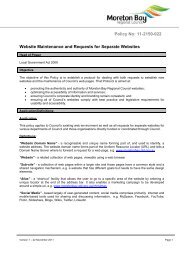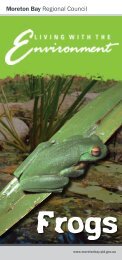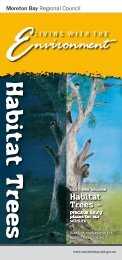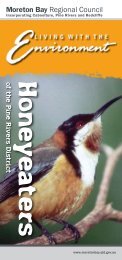Calopo - Moreton Bay Regional Council
Calopo - Moreton Bay Regional Council
Calopo - Moreton Bay Regional Council
You also want an ePaper? Increase the reach of your titles
YUMPU automatically turns print PDFs into web optimized ePapers that Google loves.
Fact sheetPEST PLANT<strong>Calopo</strong><strong>Calopo</strong>gonium mucunoidesPhoto courtesy of the Bureau of Sugar Experimental StationsNative to tropical America, <strong>Calopo</strong> was introducedas a pasture legume but has low palatability. It isan aggressive creeper that can smother supportingvegetation, including cane, and is now a widespread weedof cane fields, roadside banks, edges of rainforest andother disturbed areas.Declaration details<strong>Calopo</strong> is a not declared plant under the Land Protection(Pest and Stock Route Management) Act 2002; however,plants that are not declared under state legislation mayhave control requirements imposed by local governments.Description and general informationAn annual creeping vine with stems covered in brownishhairs. Trifoliate leaves, 3–6 cm long, leaflets rounded anddensely hairy.Pea-shaped flowers are pale bluish-purple with yellowgreencentres in clusters on stalks arising in leaf axils.Densely hairy pods are brown, narrow, flattened,constricted between the seeds and about 15 cm long.Each pod contains 5–7 brown or yellow seeds.PP130 February 2010
ControlManual controlHand pull isolated plants and small infestations, makingsure that all roots and stem fragments are removed. Plantpieces should either be bagged and taken to the dump orhung up off the ground to prevent reshooting.Herbicide controlThere is only one chemical (glufosinate-ammonium)registered for use on calopo in various agricultural andnon-agricultural situations including rights-of-way,commercial, industrial and public land in Queensland.Off-label use permit (Permit No. PER11463) allows otherherbicides for the control of environmental weeds innon-agricultural areas, bushland, forests, wetlands, andcoastal and adjacent areas.It is a requirement of the permit that all persons usingproducts covered by this off-label permit comply with thedetails and conditions listed in the permit. Permit numberPER11463 expires on 30 June 2014. While the permit maybe extended beyond this date, there is no guarantee thatit will, so contact your local council weed inspector for thelatest information after the expiry date.Follow upMonitor treated areas regularly for any new seedlingsor regrowth.Further informationFurther information is available from your localgovernment office, or by contacting BiosecurityQueensland (call 13 25 23 or visit our website atwww.deedi.qld.gov.au).See Table 1 for treatment options allowed by the permit.Prior to using the chemicals listed under PER11463 you mustread or have read to you and understand the conditions ofthe permit. To obtain a copy of this permit contact your localcouncil weed inspector or visit www.apvma.gov.auTable 1. Herbicides registered for the control of calopoMethod Herbicide Rate Registration status CommentsSpot spray (whenplants are activelygrowing)Glufosinate-ammonium(200 g/L)500 ml per 100 L cleanwaterRegistered for useUse according to labeldirectionsSpot spray Dicamba (200 g/L) 500 ml (on mature) to 1 L(on regrowth) per 100 Lwater plus wetting agentSpot spray Dicamba (500 g/L) 200 ml (on mature) to 1 L(on regrowth) per 100 LwaterSpot spray 2,4-D (300 g/L) +picloram (75 g/L)1 L per 100 L water pluswetting agentAPVMA permit PER11463Permit expires 30/06/2014APVMA permit PER11463Permit expires 30/06/2014APVMA permit PER11463Permit expires 30/06/2014Read the label carefully before use. Always use the herbicide in accordance with the directions on the label.Source: PER11463Read permit carefullyprior to useRead permit carefullyprior to useRead permit carefullyprior to useFact sheets are available from Department of Employment, Economic Development and Innovation (DEEDI) service centres and our BusinessInformation Centre (telephone 13 25 23). Check our website at www.deedi.qld.gov.au to ensure you have the latest version of this fact sheet. Thecontrol methods referred to in this fact sheet should be used in accordance with the restrictions (federal and state legislation, and local governmentlaws) directly or indirectly related to each control method. These restrictions may prevent the use of one or more of the methods referred to,depending on individual circumstances. While every care is taken to ensure the accuracy of this information, DEEDI does not invite reliance upon it,nor accept responsibility for any loss or damage caused by actions based on it.© The State of Queensland, Department of Employment, Economic Development and Innovation, 2010 PR10–4755


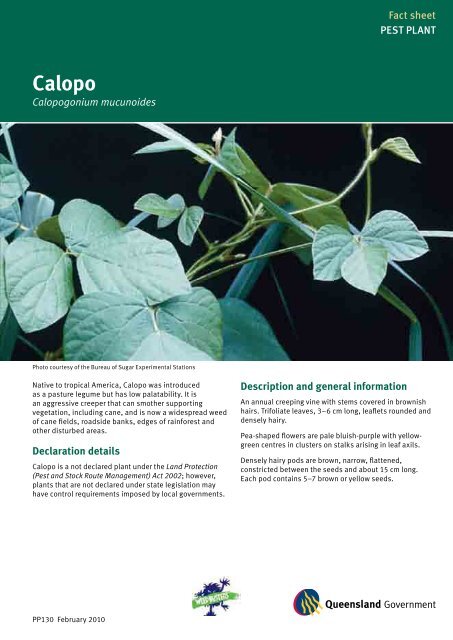
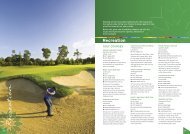

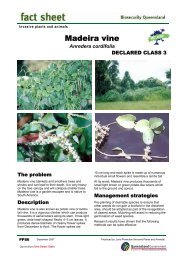
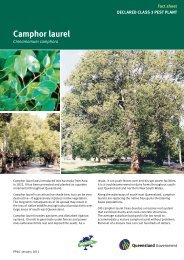


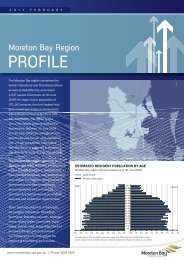

![Kumbartcho Brochure [PDF 540KB] - Moreton Bay Regional Council](https://img.yumpu.com/47220970/1/190x101/kumbartcho-brochure-pdf-540kb-moreton-bay-regional-council.jpg?quality=85)
